Keeping your roof clean isn’t just for aesthetics; it also helps extend the longevity of your roof. Roof shingles require cleaning to properly protect your home from sun, wind, and rain. There are various ways to clean roof shingles without causing damage, whether you do it yourself or call in the professionals.
Safety is the number-one factor to keep in mind when performing any type of work on your roof. For this reason, your best course of action is to hire a reputable and qualified roofing professional like Ranch Roofing to do the work for you.
But if you’re an expert do-it-yourselfer, we’ll take you through the ins and outs of cleaning roof shingles so you can make an educated decision on how to proceed. Learn why you need to clean your roof, the various methods available and supplies needed to complete the task, the steps to accomplish the cleaning, and other factors to consider when working on your roof.
In this article:
- Why Your Roof Needs Cleaning
- Various Methods for Cleaning Roof Shingles
- Supplies Needed for Cleaning Roof Shingles
- How to Clean Roof Shingles
- Factors to Consider When Cleaning Your Roof
- Final Thoughts
- Frequently Asked Questions
Why Your Roof Needs Cleaning
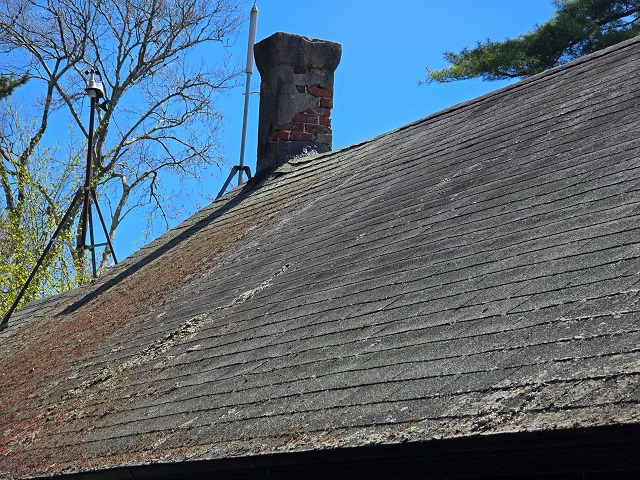
Your roof requires regular cleaning to maintain your home’s structural integrity as well as protect your home. How you clean it and how frequently depends largely on the age of your roof and the materials it’s made with. Benefits for cleaning roof shingles include:
- Risk reduction of health issues: Cleaning your roof reduces the potential for algae, mold, and moss to grow out of control and possibly cause health risks to inhabitants.
- Water damage prevention: Regularly cleaning your roof reduces the risk of debris clogging your gutters or forming a dam that prevents water from flowing naturally off your roof. Puddled water, especially if it sits for a while, can lead to shingles deteriorating, which can cause holes and lead to water leaks.
- Extending roof longevity: When you keep your roof clean, you reduce the possibility of fungal overgrowth, damage going unseen (therefore, untreated), and pests creating a mess. The better shape your roof is in, the longer it can protect your home.
- Improved energy efficiency: Anomalies or damage can alter the surface of your roof, leading to a reduction in the ability to properly reflect the sun’s heat and rays. A clean roof is less likely to break down quickly due to an overgrowth of vegetation.
- Increased curb appeal and property value: Maintaining the roof of your home keeps it looking in tip-top shape, which helps to boost the home’s curb appeal and potentially increases property value.
- Maintaining homeowners insurance and warranties: Some homeowner’s insurance policies require regular maintenance and cleaning of rooftops for the policy to remain in effect. Not maintaining your home could void warranties.
Various Methods for Cleaning Roof Shingles
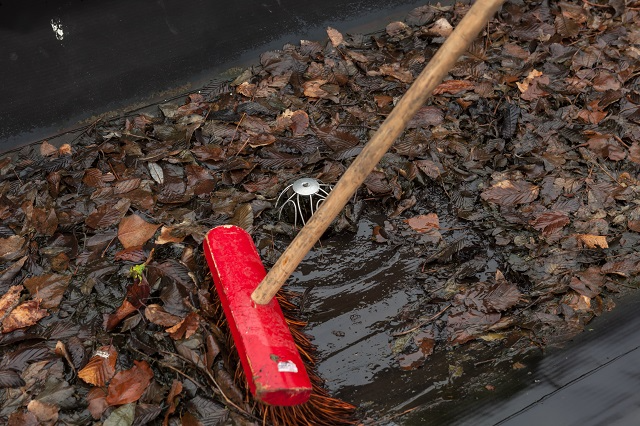
There are a variety of ways to clean your roof, but if it’s done on a regular basis or, at the very least, when it’s called for, you could potentially save money in the long run by putting off the need for repairs or a full roof replacement.
Typically, a roof should be cleaned at least once a year, but you may need to clean it more frequently if you live in an area with high humidity, it rains often, or there are many overhanging trees. If you see a lot of dirt or fungus or if water flow off the roof is obstructed, it’s time to clean your roof.
Each method has pros and cons, and the method you choose can depend on the type of shingle, size of the job, and safety factors. If you’re at all unsure about doing it yourself, contact the experts at Ranch Roofing.
Methods for cleaning your roof include:
1. Scrub brush and water
Cleaning your roof may not be complicated, but it can be laborious, time-consuming, and risky. The simplest way to clean your roof is by getting up on your roof and putting some elbow grease into it. Grab a scrub brush and hose, wet the roof, and gently scrub the shingles; rinse and repeat as necessary.
Alternatively, tools like the DOCAZOO 6-24 Foot Extension Pole and Hard Bristle Brush allow you to stand on the ground and reach some of your roof while your feet are firmly planted. This one has a maximum reach of 30 feet.
2. Pressure washing
Pressure washing isn’t typically recommended for roof shingles because of the risk of damage. Only opt for pressure washing if you understand how a pressure washer works.
Set it to the lowest setting to help reduce the risk of causing damage to your shingles. Settings around 1,500 PSI or lower are recommended for asphalt shingles.
3. Steam cleaning
Using the power of steam, you can effectively clean mold, algae, and dirt from your shingles without the use of harsh chemicals. You will need a commercial steam cleaner for the job.
4. Chemical cleaners
While just water can make a great difference in cleaning your roof, sometimes you need something stronger. Chemical cleaners like bleach, soap, or a commercial cleaner can be applied to shingles to help eliminate dirt and mold.
Mix water and bleach in a 4-to-1 ratio or get a pre-made solution like Simple Green Oxy Solve to gently but effectively wash your roof. Spray your chosen solution on the roof, let it sit, and then rinse it off.
5. Hire a professional
The best method for cleaning your roof without doing any damage is to hire a professional to do the work. Ranch Roofing has been a trusted source for roofing services for more than 25 years. We’ll work with you to help you determine if it’s time to clean your roof and the best solution for your needs.
The table below provides an overview of the different roof shingle cleaning methods and the pros and cons of each.
| Cleaning Method | Description | Pros | Cons |
| Scrub brush & water | Manual scrubbing with a water hose | Safe for shingles
Minimal cost |
Labor-intensive
Time-consuming |
| Pressure washing | High-pressure water cleaning | Efficient for cleaning large areas | Risk of shingle damage if not used carefully |
| Steam cleaning | Uses steam to clean mold and algae | No harsh chemicals required | Requires a commercial steam cleaner |
| Chemical cleaners | Uses bleach or commercial cleaning solutions | Highly effective on tough stains | Potential harm to plants
Requires safety precautions |
| Hire a professional | Professional with specialized equipment | Ensures safe and thorough cleaning | Higher cost compared to DIY methods |
Supplies Needed for Cleaning Roof Shingles
With a variety of cleaning methods to choose from, there are just as many cleaning supplies required to take proper care of your roof shingles. You may need the following:
Safety Equipment
The top priority when it comes to doing any type of roofing work is safety. Consider procuring the following items, depending on the type of cleaning method you choose to use:
- Sturdy and dependable ladder, like the 14-foot Louisville Ladder FM1414HD Twin Front Stepladder, for safely reaching and accessing your roof
- Safety harness if you are physically getting up on your roof, especially if it’s steep
- Work boots with good traction for walking on your roof safely
- Gloves to protect your hands from possible injury due to chemicals or debris
Tools and Solutions
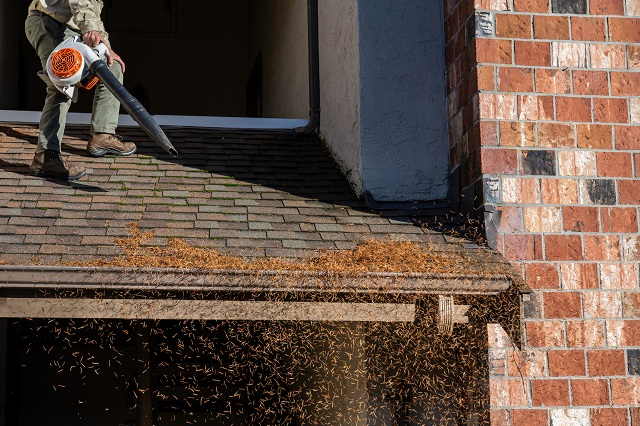
To properly and effectively clean your roof shingles, you may need to take a trip to the hardware store. The tools and solutions you use can be simple to complex and depend on the type of cleaning you need to do. Consider the following:
- Bristle brush: This can be a hand-held brush for up-close work or a long-handled brush for cleaning from the ground. A brush should feature soft bristles so it doesn’t damage the shingles.
- Water source: It can be difficult to wash your roof without water. You’ll need a garden hose that’s long enough to reach your roof safely. Consider one with a spray nozzle.
- Broom, rake, or blower: Cleaning your roof requires removing debris like twigs, leaves, and moss before washing the shingles. Long-handled brooms and roof rakes, as well as leaf blowers, can gently and effectively remove excess debris from your roof.
- Pressure washer: To pressure wash your roof, you’ll need a pressure washer that features adjustable settings so you can set it to the lowest pressure available.
- Bleach, soap, or commercial cleaner: Decide how you want to clean the shingles. Options range from homemade solutions like bleach and water or soapy water to store-bought commercial cleaners. Don’t forget a bucket if you need to mix the solution yourself.
- Drop cloths: The outside of your home should be protected during cleaning. There’s a high probability of falling debris, and drop cloths or plastic sheets can help prevent damage to shrubbery or outdoor furniture.
If cleaning your roof shingles seems too risky or your roof is high or steep, it’s wise to hire experienced professionals who have the right kind of equipment and experience to handle the job safely.
How to Clean Roof Shingles
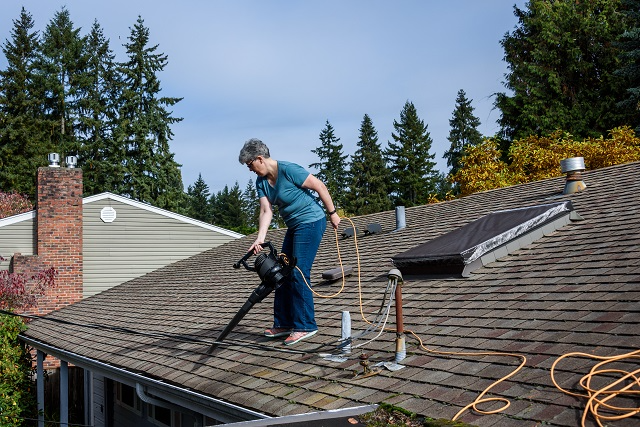
While we strongly recommend hiring a qualified roofing professional, such as Ranch Roofing, to clean your roof for you, if you’re set on doing it yourself, remember to practice safety first. Roofs can be steep and slippery, and cleaning your roof is not worth risking injury. Follow these steps to clean your roof without damaging the shingles:
- Double-check the current warranty on your roof. It may require a roofing professional to do the cleaning in order to maintain the warranty.
- Ensure you have all the proper equipment: sturdy ladder, safety harness, proper footwear, and gloves. Consider using drop cloths or plastic sheets to cover areas outside your home to protect it from falling debris off the roof.
- Choose a calm and dry day to clean your roof. High winds increase the risk of falling off your roof. Rain or high humidity could impede a proper cleaning.
- Choose a cleaning method, and be sure to have all the supplies needed before you get started.
- Inspect your roof for damaged areas or missing shingles. Make necessary repairs before you begin cleaning.
- Remove excess debris and dirt using a roof rake, shovel, or brush. You can also use a leaf blower to help blow leaves, twigs, and moss off your roof.
- Prepare your roof shingles, regardless of the cleaning method you choose. Douse your shingles in water using your garden hose.
- Apply your cleaning solution according to the directions. Remember to wear protective clothing – everything from a face mask to gloves to boots – to protect yourself from splashing or dripping chemicals. Many cleaning solutions require a set amount of time to effectively kill bacteria or fungus.
- Thoroughly rinse your roof after the cleaning solution has had time to set and work. Use a pressure washer (on low) or garden hose to wash away the cleaning solution and leftover grime.
- Do a final inspection to ensure you cleaned all necessary spots that needed cleaning. This will help you determine if you need to apply a second coat of cleaning solution.
- Perform a final cleanup around your home. Make sure your property is safe from dangerous debris or cleaning solution runoff.
Factors to Consider When Cleaning Your Roof
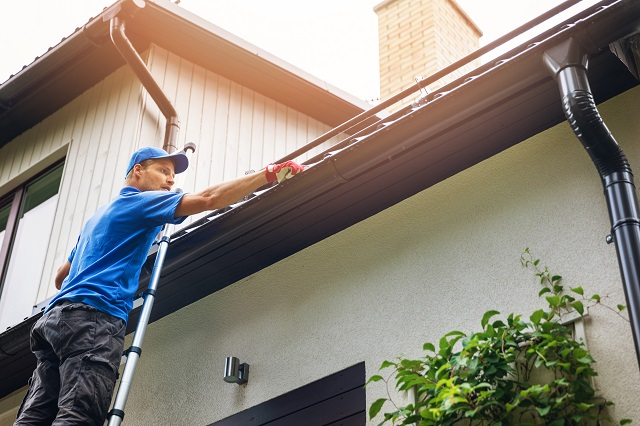
Before you jump up on your roof to give it a good cleaning, there are a number of factors to consider:
Safety
It can’t be stressed enough that safety should be your number-one priority. Make sure you have the proper equipment to protect yourself and do the job without risk of injury. Keep an eye on the sky and only clean your roof when the weather is calm and comfortable.
Contact your local roofing professional if you’re concerned about trying to clean the roof yourself. Ranch Roofing is qualified to safely, effectively, and efficiently perform roofing services in your area. Call us for your free quote.
Roof Type
Consider the type of roofing material on your roof when deciding on a cleaning method. Asphalt, metal, wood, slate, and tile all require different cleaning methods and pressures. For example, asphalt shingles require a lighter washing method with lower pressure in order to reduce the chance of damaging the shingles.
The age and condition of your roof can affect how it gets cleaned or if it can even be cleaned in the first place. Another reason why it’s wiser to call a roofing professional. We can help you determine whether or not your roof can be safely cleaned or if it’s in need of replacement.
Cleaning Method
There are a variety of cleaning methods to consider before you get started. Asphalt shingle roofing is best done with low-pressure washing, soft-bristled brushes, and a cleaning solution that won’t strip any color.
Tools and Equipment
Cleaning roof shingles requires the right equipment to complete the job safely and effectively. If you don’t have the proper tools on hand, you may need to purchase or rent them.
Environmental Impact
Keep the outside environment in mind when you’re preparing to clean your roof. Be mindful of low-hanging trees, nesting birds, and shrubbery surrounding your home. Also, consider where the water and cleaning solution run off your roof.
Homeowners Insurance and Warranty
Check with your homeowner’s insurance and any warranties on your roof. Some manufacturers require certain cleaning methods or specify the need for professional cleaning in order to maintain the insurance or warranty.
Legal Regulations
Depending on the area you live in, you may need to check with local requirements regarding servicing your roof. Homeowners Association (HOA) or local regulations may have rules about roof maintenance or cleaning, especially considering runoff and disposal of cleaning solutions.
DIY vs. Professional Cleaning
Consider whether or not you really want to clean the roof yourself or just hire someone to do it. While roof cleaning is not overly complicated, it is risky, time-consuming, and could be more expensive than professional cleaning if you don’t already have the right equipment.
Ranch Roofing has been installing, repairing, and cleaning roofs for more than 25 years, becoming a well-trusted residential roofing company. We use only the highest quality materials and treat your home like our own. Contact us for more details.
Time and Scheduling
Between the weather and your personal schedule, it can take some time to adequately and effectively complete the job. Larger houses or those with steep roofs may require more time to clean. Roofing professionals can clean your roof in a timely manner, freeing you up to spend more time with your family.
Final Thoughts
Cleaning roof shingles involves having the right equipment (safety equipment and cleaning tools), working at great heights or on a steep slope, and potentially handling hazardous materials. Working on your roof carries the risk of injury.
The right roofing professional is well-equipped with all the proper tools and safety gear needed to clean your roof without incident. Qualified roofing professionals work within local laws, are insured and licensed, and can tackle a roofing project quickly, efficiently, and correctly. Additionally, when a qualified roofer cleans your roof, they can make any necessary repairs along the way, helping your roof to last as long as possible.
Get in touch with us today and let the professional roofers at Ranch Roofing handle the job for you.
Frequently Asked Questions
What is the best solution to clean roof shingles?
The best solution to clean roof shingles is to call a professional. Ranch Roofing has been serving the Boston area for more than 25 years and knows the roofing industry backward and forward. Let us work with you to determine the best course of action for cleaning your roof.
Can you pressure wash roof shingles?
It is not recommended to pressure wash roof shingles due to the risk of damage. If you do use a pressure washer to clean your roof, it must be tuned to the lowest setting to ensure a lighter amount of water pressure.
How do you remove mold and algae from roof shingles?
Removing algae and mold from roof shingles requires a powerful chemical agent like bleach or commercial solutions designed for heavy-duty cleaning. Always follow directions and take precautions when using chemicals to prevent skin burns or lung damage.
How to clean black off of roof shingles?
Roof shingles that feature black stains can be cleaned with a mixture of bleach, trisodium phosphate, and water.
